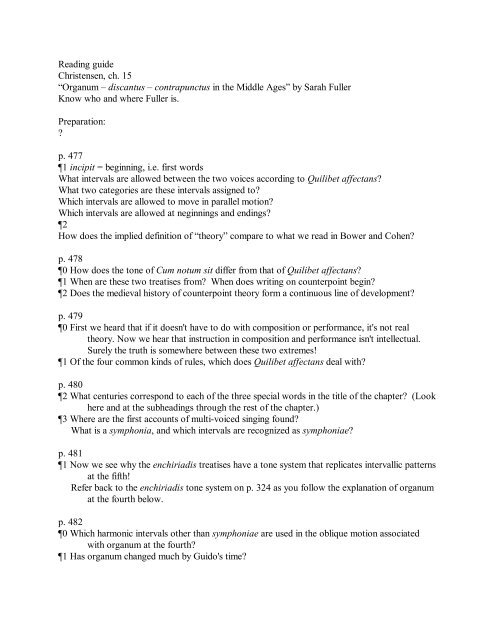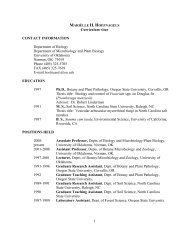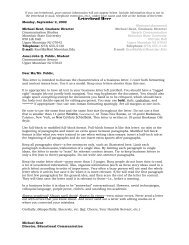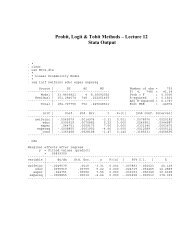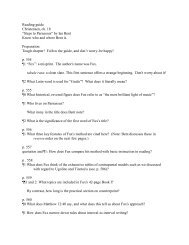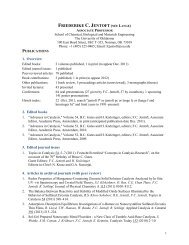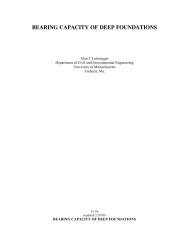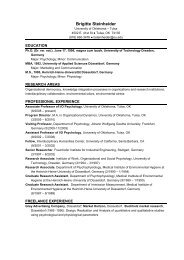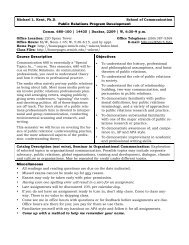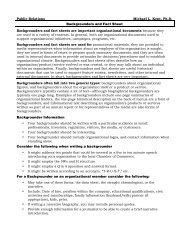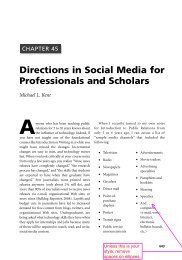Organum – discantus – contrapunctus in the Middle Ages
Organum – discantus – contrapunctus in the Middle Ages
Organum – discantus – contrapunctus in the Middle Ages
You also want an ePaper? Increase the reach of your titles
YUMPU automatically turns print PDFs into web optimized ePapers that Google loves.
Read<strong>in</strong>g guide<br />
Christensen, ch. 15<br />
“<strong>Organum</strong> <strong>–</strong> <strong>discantus</strong> <strong>–</strong> <strong>contrapunctus</strong> <strong>in</strong> <strong>the</strong> <strong>Middle</strong> <strong>Ages</strong>” by Sarah Fuller<br />
Know who and where Fuller is.<br />
Preparation:<br />
?<br />
p. 477<br />
1 <strong>in</strong>cipit = beg<strong>in</strong>n<strong>in</strong>g, i.e. first words<br />
What <strong>in</strong>tervals are allowed between <strong>the</strong> two voices accord<strong>in</strong>g to Quilibet affectans?<br />
What two categories are <strong>the</strong>se <strong>in</strong>tervals assigned to?<br />
Which <strong>in</strong>tervals are allowed to move <strong>in</strong> parallel motion?<br />
Which <strong>in</strong>tervals are allowed at neg<strong>in</strong>n<strong>in</strong>gs and end<strong>in</strong>gs?<br />
2<br />
How does <strong>the</strong> implied def<strong>in</strong>ition of “<strong>the</strong>ory” compare to what we read <strong>in</strong> Bower and Cohen?<br />
p. 478<br />
0 How does <strong>the</strong> tone of Cum notum sit differ from that of Quilibet affectans?<br />
1 When are <strong>the</strong>se two treatises from? When does writ<strong>in</strong>g on counterpo<strong>in</strong>t beg<strong>in</strong>?<br />
2 Does <strong>the</strong> medieval history of counterpo<strong>in</strong>t <strong>the</strong>ory form a cont<strong>in</strong>uous l<strong>in</strong>e of development?<br />
p. 479<br />
0 First we heard that if it doesn't have to do with composition or performance, it's not real<br />
<strong>the</strong>ory. Now we hear that <strong>in</strong>struction <strong>in</strong> composition and performance isn't <strong>in</strong>tellectual.<br />
Surely <strong>the</strong> truth is somewhere between <strong>the</strong>se two extremes!<br />
1 Of <strong>the</strong> four common k<strong>in</strong>ds of rules, which does Quilibet affectans deal with?<br />
p. 480<br />
2 What centuries correspond to each of <strong>the</strong> three special words <strong>in</strong> <strong>the</strong> title of <strong>the</strong> chapter? (Look<br />
here and at <strong>the</strong> subhead<strong>in</strong>gs through <strong>the</strong> rest of <strong>the</strong> chapter.)<br />
3 Where are <strong>the</strong> first accounts of multi-voiced s<strong>in</strong>g<strong>in</strong>g found?<br />
What is a symphonia, and which <strong>in</strong>tervals are recognized as symphoniae?<br />
p. 481<br />
1 Now we see why <strong>the</strong> enchiriadis treatises have a tone system that replicates <strong>in</strong>tervallic patterns<br />
at <strong>the</strong> fifth!<br />
Refer back to <strong>the</strong> enchiriadis tone system on p. 324 as you follow <strong>the</strong> explanation of organum<br />
at <strong>the</strong> fourth below.<br />
p. 482<br />
0 Which harmonic <strong>in</strong>tervals o<strong>the</strong>r than symphoniae are used <strong>in</strong> <strong>the</strong> oblique motion associated<br />
with organum at <strong>the</strong> fourth?<br />
1 Has organum changed much by Guido's time?
p. 483<br />
0 What four harmonic <strong>in</strong>tervals are used <strong>in</strong> “flexible” organum accord<strong>in</strong>g to Guido.<br />
Note: it is common to rank <strong>the</strong> harmonic <strong>in</strong>tervals. What is Guido's order<strong>in</strong>g?<br />
p. 484<br />
How closely do <strong>the</strong> <strong>the</strong>oriectical accounts seem to reflect practice?<br />
Chapter 15 <strong>–</strong> p. 2<br />
p. 485<br />
Head<strong>in</strong>g and 1 What o<strong>the</strong>r term is used to refer to two-part writ<strong>in</strong>g <strong>in</strong> <strong>the</strong> 1200s?<br />
What is <strong>the</strong> significance of <strong>the</strong> new term?<br />
What “retronym” is given to chant? (Ask me <strong>in</strong> class about retronyms.)<br />
How are <strong>the</strong> eight modes treated <strong>in</strong> <strong>the</strong> <strong>discantus</strong> <strong>the</strong>ories?<br />
How is <strong>the</strong> word mode used <strong>in</strong> <strong>the</strong> <strong>discantus</strong> writ<strong>in</strong>gs?<br />
2 Who is <strong>the</strong> author of <strong>the</strong> key Parisian treatise on musica mensurabilis? What is its title?<br />
th<br />
Coussemaker was a 19 -century French musicologist who discovered, collected, and<br />
transcribed many early manuscripts on music. He published a four-volume set of Lat<strong>in</strong><br />
works entitled Scriptorum de musica.<br />
p. 486<br />
0 Accord<strong>in</strong>g to John of Garland, how are <strong>the</strong> two <strong>in</strong>dependent voices coord<strong>in</strong>ated?<br />
How many harmonic <strong>in</strong>tervals does John put <strong>in</strong>to his hierarchy? How are <strong>the</strong>y ordered? Are<br />
<strong>the</strong>re any surprises <strong>the</strong>re?<br />
What numerical justification does John give for his hierarchy? What details show that he isn't<br />
exclusively follow<strong>in</strong>g an abstract ma<strong>the</strong>matical <strong>the</strong>ory <strong>in</strong> construct<strong>in</strong>g his scheme?<br />
p. 487<br />
1 A little confus<strong>in</strong>g: an earlier treatise is named, but I th<strong>in</strong>k <strong>the</strong> rest of <strong>the</strong> paragraph cont<strong>in</strong>ues<br />
to refer to John of Garland.<br />
What two reasons are given for waiv<strong>in</strong>g certa<strong>in</strong> rules based on <strong>the</strong> <strong>in</strong>tervallic heirarchy?<br />
John of Garland is characterized as part of an <strong>in</strong>tellectual tradition of <strong>discantus</strong> writ<strong>in</strong>g. Why?<br />
2 What characterizes <strong>the</strong> o<strong>the</strong>r tradition of <strong>discantus</strong> writ<strong>in</strong>g?<br />
p. 488<br />
1 A little confus<strong>in</strong>g aga<strong>in</strong>. Note that Fuller now places “Discantus positio vulgaris” among <strong>the</strong><br />
treatises that show which <strong>in</strong>tervals to write with few explanations. Notice that <strong>the</strong> title<br />
<strong>in</strong>dicates that this is <strong>the</strong> common way to do it, not <strong>the</strong> elite way.<br />
Are accidentals mentioned <strong>in</strong> <strong>the</strong>se treatises?<br />
What k<strong>in</strong>ds of general rules are mentioned occasionally?<br />
p. 489<br />
0 Accord<strong>in</strong>g to Fuller, why does <strong>the</strong> <strong>in</strong>tervallic-succession tradition avoid general explanatory<br />
rules? What do you th<strong>in</strong>k: Did this policy necessarily reflect good pedagogy?<br />
1 Accord<strong>in</strong>g to Anonymous IV, what dist<strong>in</strong>guishes discantors from pla<strong>in</strong> s<strong>in</strong>gers?
Chapter 15 <strong>–</strong> p. 3<br />
p. 490<br />
1 Fuller says that variety of content among <strong>contrapunctus</strong> treatises, most of which exist <strong>in</strong> only<br />
one copy, suggests an <strong>in</strong>formal pedagogical motivation. Why do you th<strong>in</strong>k this would be<br />
so? What o<strong>the</strong>r k<strong>in</strong>d of treatise does Fuller mention here?<br />
th<br />
2 In <strong>the</strong> new, 14 -century term<strong>in</strong>ology, what is <strong>the</strong> difference between <strong>contrapunctus</strong> and<br />
discant?<br />
p. 491<br />
0 How do <strong>the</strong> new rhythmic ideas of rhe ars nova relate to <strong>contrapunctus</strong> teach<strong>in</strong>g?<br />
1 What <strong>in</strong>tervals beg<strong>in</strong> to counted among <strong>the</strong> consonances (suitable for note-aga<strong>in</strong>st-note<br />
counterpo<strong>in</strong>t) <strong>in</strong> this new phase?<br />
What <strong>in</strong>terval formerly commonly counted as a symphonia is now not among <strong>the</strong><br />
consonances?<br />
How do <strong>the</strong> <strong>the</strong>orists talk about unstable <strong>in</strong>tervals?<br />
What are <strong>the</strong> most common comb<strong>in</strong>ations of imperfect <strong>in</strong>terval and resolution?<br />
What staple pattern of organum is now prohibited <strong>in</strong> contrpunctus teach<strong>in</strong>g?<br />
p. 492<br />
1 This topic may get overlooked <strong>in</strong> this book: The Berkeley manuscript, sometimes attributed to<br />
Goscalcus, recognized various accidentals and added <strong>the</strong>m to <strong>the</strong> accepted tone system by<br />
means of Guidonian hexachords <strong>in</strong> different places. Any accidental makes a half step, and<br />
MI-FA marks <strong>the</strong> half step <strong>in</strong> <strong>the</strong> hexachord. So F can occur if G becomes FA. E can<br />
occur if D becomes MI.<br />
2 Add <strong>the</strong>se three names to your list of <strong>the</strong>orists. Go through <strong>the</strong> example carefully and note<br />
how accidentals are used to make <strong>the</strong> imperfect <strong>in</strong>terval as “close” to <strong>the</strong> perfect <strong>in</strong>terval<br />
as possible while still be<strong>in</strong>g consonant. (Refer back to <strong>the</strong> three common comb<strong>in</strong>ations of<br />
<strong>in</strong>tervals on p. 491.) In each case, what <strong>in</strong>terval would be occur without <strong>the</strong> <strong>in</strong>flection?<br />
What <strong>in</strong>terval would result if a second accidental were added, mak<strong>in</strong>g <strong>the</strong> imperfect<br />
<strong>in</strong>terval even closer to <strong>the</strong> perfect consonance ?<br />
p. 493<br />
0 Who characterizes ficta as color<strong>in</strong>g a note? What word do we use that comes from <strong>the</strong> Greek<br />
for color?<br />
1 What two treatises are mentioned as teach<strong>in</strong>g how to create rhythmicized, elaborate<br />
decorations of note-to-note <strong>contrapunctus</strong>?<br />
p. 494<br />
0 What comb<strong>in</strong>ation does <strong>the</strong> “Parisian <strong>the</strong>orist” (Goscalcus, author of <strong>the</strong> Berkeley manuscript<br />
of 1375) see as a basic error even <strong>in</strong> elaborated polyphony?<br />
1 Dissonances beg<strong>in</strong> to be discussed <strong>in</strong> <strong>the</strong> treatises on decoration. How much are <strong>the</strong>y used?<br />
2 etc. Here's a method for improvis<strong>in</strong>g a big, complex sound that requires only one s<strong>in</strong>ger versed<br />
<strong>in</strong> contrapuntal technique. It's a k<strong>in</strong>d of music that doesn't get <strong>in</strong>to anthologies because it<br />
never got written down. How is this technique like and unlike <strong>the</strong> doo-wop texture of 50
years ago or o<strong>the</strong>r improvised, popular vocal textures?<br />
Chapter 15 <strong>–</strong> p. 4<br />
p. 496<br />
1 How does <strong>the</strong> Italian gradus system make beg<strong>in</strong>n<strong>in</strong>g counterpo<strong>in</strong>t easier?<br />
2 How does <strong>the</strong> English “sights” system work, and how is it similar to <strong>the</strong> gradus system?<br />
p. 497<br />
1 What restrictions does <strong>the</strong> faburden system add to <strong>the</strong> sights system? What three-note<br />
sonorities result? What contrapuntal rules does <strong>the</strong> faburden system follow that <strong>the</strong> sights<br />
system may not?<br />
p. 498<br />
1 What fifteenth-century <strong>the</strong>orist transmits English faburden practice to Italy?<br />
2 and p. 499 0 Fuller stretches <strong>the</strong> term “<strong>Middle</strong> <strong>Ages</strong>” and looks to <strong>the</strong> future here. How<br />
does <strong>the</strong> Renaissance <strong>the</strong>orist T<strong>in</strong>ctoris differ from most contrapuntal <strong>the</strong>orists before him.<br />
th<br />
What earlier 15 -century <strong>the</strong>orist makes this dist<strong>in</strong>ction? (More on <strong>the</strong>se two and Ugol<strong>in</strong>o<br />
<strong>in</strong> o<strong>the</strong>r chapters.)<br />
p. 499<br />
1 Hugo Riemann's book is considered <strong>the</strong> first attempt at a comprehensive history of music<br />
<strong>the</strong>ory. What criticism does Fuller have of <strong>the</strong> book?<br />
Summary<br />
What three stages of <strong>the</strong>ory does Fuller outl<strong>in</strong>e?<br />
What two treatises does she present as representative of <strong>the</strong> first stage? How do <strong>the</strong>ir focuses<br />
differ?<br />
What two treatises does she present from <strong>the</strong> second stage? How do <strong>the</strong>ir focuses differ?<br />
What branches of <strong>contrapunctus</strong> <strong>the</strong>ory does Fuller trace? Who respresents each?


